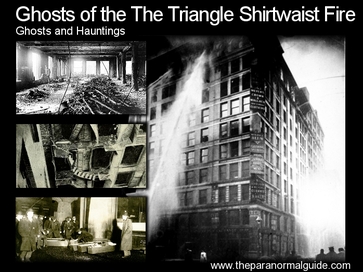
Now refurbished and renamed the building sees remnants of the past played out before people's eyes.
A Horrific Tragedy
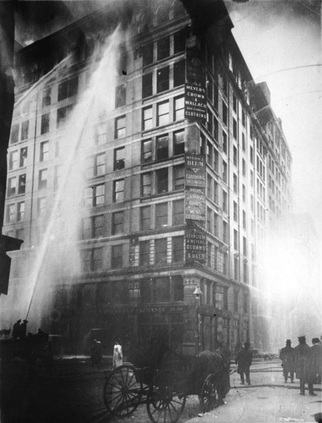 The building aflame.
The building aflame. Soon after, as the crowd watched, a man and women kissed before taking the drop to their deaths.
This event, that was to become known as the 'Triangle Shirtwaist Factory Fire', would draw upwards of 20,000 spectators as 146 people perished in the flames or on the sidewalk below. The eldest fatality was a woman aged 43 and the youngest just 11 (some sources say 14) years of age.
Towering Inferno
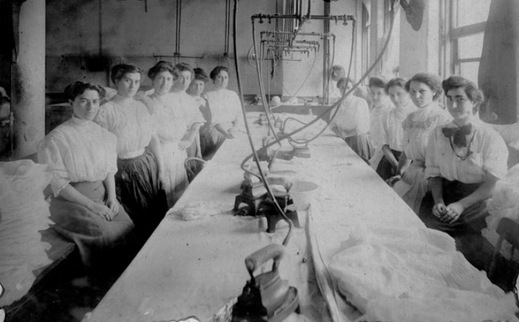 Women of the Triangle Shirtwaist.
Women of the Triangle Shirtwaist. The tenth floor was warned of the danger through a telephone system, but there was no way to warn those on the ninth floor, who continued working until they themselves noticed the smoke coming through the windows.
As can be expected, the workers all displayed great haste in wanting to leave the path of the flames, which would soon engulf the upper three floors occupied by the factory. Many people crammed into the elevators to escape, while others made way to the fire escapes and emergency doors.
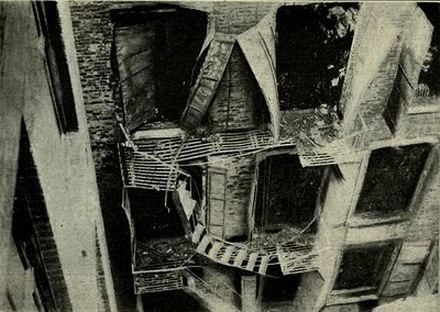 The emergency stairs buckled and broke under the weight.
The emergency stairs buckled and broke under the weight. Many of the working women pounded on the doors in order to draw attention, to get them opened. Unfortunately the foreman who held the keys had made a run for it, as soon as he noticed the smoke, leaving everyone trapped on the upper floors.
The elevators moved excruciatingly slow so many of the workers made their way to external fire escape stairwells, but within a matter of minutes one was blocked at both ends due to flames. Everyone rushed to the other stairwell, and in their panic at fleeing the fire, they over crowded it. The flimsy metal construction crumpled under their combined weight, sending 25 people to their deaths on the pavement below.
Two elevator operators continued working the elevators as long as they could. The first of these elevators stopped running when the heat buckled the guide rails of his elevator. The second elevator continued running until the operator began hearing loud thumps and bangs coming from above.
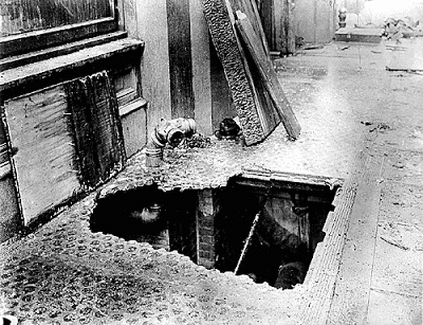 Some jumpers hit so hard they broke through the sidewalk.
Some jumpers hit so hard they broke through the sidewalk. With the fire escapes all blocked by fire or collapsed, the elevators not working and the other exits locked, people made their way to the roof or windows in order to put distance between themselves and the fire. Soon, as the fire spread to the outer reaches of the buildings, people had two choices – allow themselves to be overcome by smoke and fire, or jump the thirty meters and hope to be caught by the firemen's nets below – their ladders unable to reach beyond the sixth floor.
The first few jumpers made it safely. A man was witnessed helping women make the decision by escorting them out of a window and dropping them safely to the net below. Unfortunately the nets could take only so many impacts and soon started to break. At times workers jumped in twos and threes, which was too much for the nets to handle.
In all 146 people died as a result of the fire. 129 were women and 17 were men. Around 60 of these were located on the sidewalk where they jumped or fell. Six of the victims were not identified initially and were only finally identified in 2011, a full hundred years after the tragedy.
All for $20
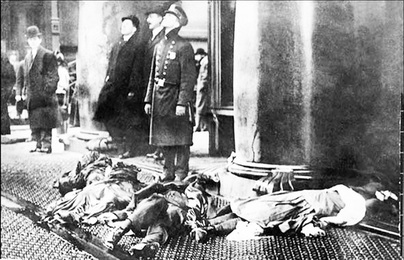 This photo played a major part in factory safety reforms.
This photo played a major part in factory safety reforms. New work safety reforms were created as a result of the fire, including better access to exits and no more locking of doors during working hours. Even so, one of the factory owners was later arrested for locking the doors at another of his factories during working hours.
The building itself survived the fire and the upper most floors were refurbished to accommodate a library and classrooms for New York University. It is now known as the brown building, and is not without its resident ghosts.
Many of those who have visited or worked in the building since its refurbishment have felt in irrational sense of wanting to flee. The panic wells up within them, seemingly without reason, and many who unable to take it leave.
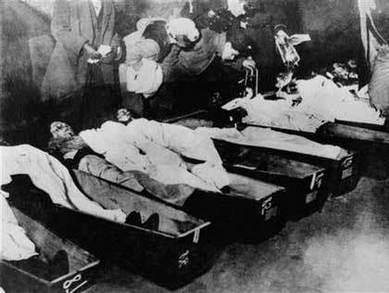 Many arrived to help identify bodies.
Many arrived to help identify bodies. On the ninth floor, just as you leave the elevator there is a tall rectangular mirror. At times, those who look in the mirror do not recognise the person who is looking back. Generally the similar features are there, the clothes are the same and the stance is the same but the head and face flicker, as if being viewed through a flame.
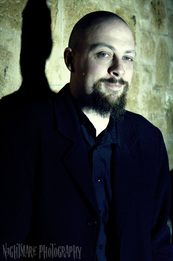




 RSS Feed
RSS Feed
